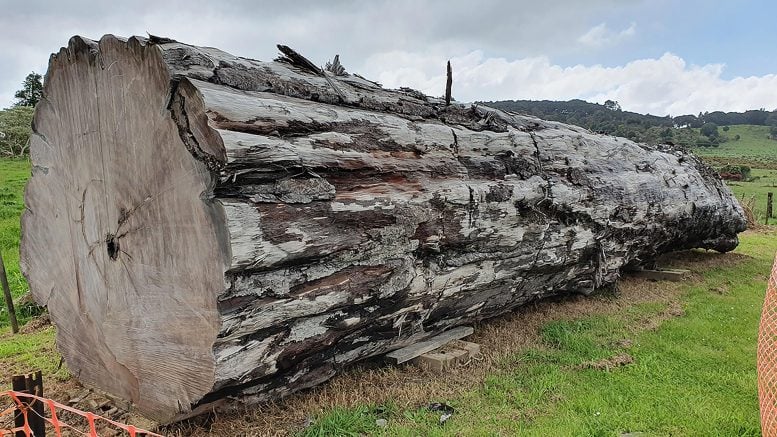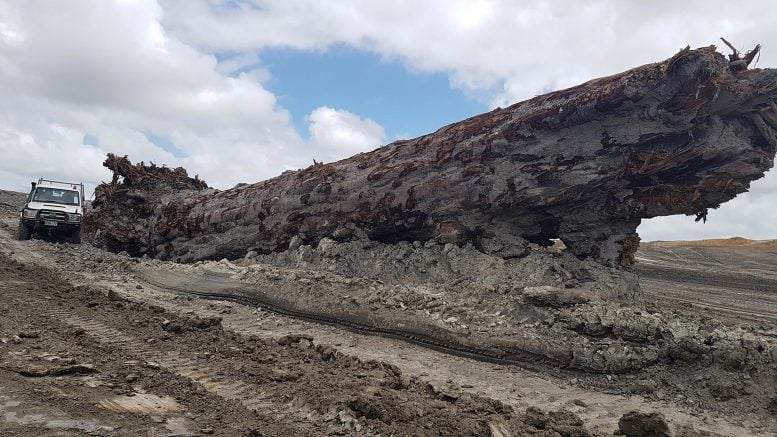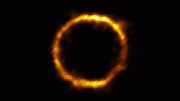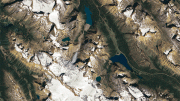Radiocarbon measurements on the remains of 42,000-year-old New Zealand kauri trees provide the basis for better calibration of geological archives of this period.
The last complete reversal of the Earth’s magnetic field, the so-called Laschamps event, took place 42,000 years ago. Radiocarbon analyses of the remains of kauri trees from New Zealand now make it possible for the first time to precisely time and analyze this event and its associated effects, as well as to calibrate geological archives such as sediment and ice cores from this period. Simulations based on this show that the strong reduction of the magnetic field had considerable effects in the Earth’s atmosphere. This is shown by an international team led by Chris Turney from the Australian University of New South Wales, with the participation of Norbert Nowaczyk from the German Research Centre for Geosciences Potsdam and Florian Adolphi from the Alfred Wegener Institute, in a study that now appears in the journal Science.
The Earth’s magnetic field undergoes permanent fluctuations and occasionally even reversals of polarity occur. Their causes, course, and effects are not yet fully understood. Researchers have now investigated the so-called Laschamps event in more detail. It refers to the last complete reversal of the polarity of the Earth’s magnetic field around 42,000 years ago. Not only did the magnetic field change direction, it also dramatically lost strength over a period of several hundred years.
About 42,000 years ago, the magnetic north pole moved south. Within this process, which lasted about 500 years, the magnetic field weakened to between six and zero percent. During a period of about 500 years, the poles remained reversed, with a field strength that varied below 28 percent of today’s value, only to reverse again over the course of about 250 years.
This exact chronological classification is now possible by linking different data sets. Firstly, the researchers used results on the Earth’s magnetic field from sediment cores of the Black Sea by Norbert Nowaczyk and his team from 2013, which were matched with Greenland ice cores via climate variation documented at the same time.
Secondly, the exact analysis and dating of the events was only made possible by the radiocarbon (14C) analysis of a sub-fossil kauri tree that grew in the wetlands of Ngawha in northern New Zealand for around 1700 years during the period in question and was subsequently very well preserved in the swamps.
Chris Turney had reported on this finding from about 40,000 years ago during a visit to the German Research Centre for Geosciences in Potsdam (GFZ) a few years ago. “As a geomagnetic scientist, I immediately had a link to the Laschamps event in mind and suggested 14C analyses, which had not yet been done on trees from that time,” says Nowaczyk, who heads the Laboratory for Palaeo- and Rock Magnetism at the GFZ.
The background: With the dwindling of the magnetic field, the Earth is losing an important protective shield against cosmic radiation, at least in part. This is also reflected in increased levels of the radioactive carbon isotope 14C in the trees. The reason for that is the increased formation of 14C in the Earth’s atmosphere during the bombardment of nitrogen by high-energy, electrically charged cosmic particles.
“The sub-fossil kauri trees are an exciting archive of atmospheric composition,” says Florian Adolphi, palaeoclimatologist at the Alfred Wegener Institute, Helmholtz Centre for Polar and Marine Research (AWI). These trees can live for several thousand years and record annual variations in atmospheric radiocarbon content as they grow, which the research team measured precisely.
“These data improve the calibration curve for radiocarbon dating, allowing more accurate dating of a wide range of climate archives and fossils. They also allow a direct comparison to ice cores: beryllium isotopes measured there show similar variations to the radiocarbon in the trees, as the production of both isotopes in the Earth’s atmosphere depends on the intensity of cosmic rays hitting the Earth,” explains the study’s co-author. He uses this effect to synchronize trees and ice cores with high precision and reduce the uncertainty of comparing the two archives from several thousand years to about 100 years.
To investigate further effects of the weak Earth’s magnetic field on the atmosphere and thus also on the global climate, the researchers carried out simulations of atmospheric chemistry. Among other things, they found a decrease in ozone. “Unfiltered radiation from space was breaking up air particles in the Earth’s atmosphere, separating electrons and emitting light — a process called ionization,” Turney explains. “The ionized air ‘sizzled’ the ozone layer.” This triggered a wave of changes in the atmosphere, including increased dazzling light shows that we know as the aurora borealis, which at the time may have been observed not only near the poles but across the globe.
It is important to further analyze the effects of the weak magnetic field in this direction in view of current developments, says Nowaczyk. Because the Earth’s magnetic field has already been weakening for about 2000 years. Compared to the first direct measurements 170 years ago, a weakening of nine percent was observed, in the area of the South Atlantic even thirty percent. Whether this means that a pole reversal is in the offing for the next one to two thousand years is debatable. However, a collapse of the natural radiation shield would pose a great challenge to our present-day society, which is very much based on electronics.
On the basis of these new possibilities for the chronological classification of the events 42,000 years ago, the main authors of the study put forward even more far-reaching hypotheses about the effects of the Earth’s magnetic field reversal — for example with regard to the extinction of the Neanderthals or the onset of cave paintings. Nowaczyk does not rule out the possibility that there are causal connections here, but considers it rather unlikely.
For more on this research, read Earth’s Magnetic Field Reversal 42,000 Years Ago Triggered a Global Environmental Crisis.
Reference: “A global environmental crisis 42,000 years ago” by Alan Cooper, Chris S. M. Turney, Jonathan Palmer, Alan Hogg, Matt McGlone, Janet Wilmshurst, Andrew M. Lorrey, Timothy J. Heaton, James M. Russell, Ken McCracken, Julien G. Anet, Eugene Rozanov, Marina Friedel, Ivo Suter, Thomas Peter, Raimund Muscheler, Florian Adolphi, Anthony Dosseto, J. Tyler Faith, Pavla Fenwick, Christopher J. Fogwill, Konrad Hughen, Mathew Lipson, Jiabo Liu, Norbert Nowaczyk, Eleanor Rainsley, Christopher Bronk Ramsey, Paolo Sebastianelli, Yassine Souilmi, Janelle Stevenson, Zoë Thomas, Raymond Tobler and Roland Zech, 19 February 2021, Science.
DOI: 10.1126/science.abb8677











“The ionized air ‘sizzled’ the ozone layer.”
Unless Turney can tell us how a plasma impacts the passage of UV, his speculations may be premature. In any event, I strongly suspect that any UV-C that made it through the stratosphere would create ozone at lower altitudes, and in the process, be absorbed. So, there would be temperature changes in the upper-troposphere, but I don’t think that there would be UV fluxes much greater than experienced by humans and animals today in the Himalayas. Melanomas are more of a problem in Australia than in Tibet.
The true test of our electromagnetic field over the eons, comes from core samples pulled of magnetic rock. They should know that a complete reversal of the Poles happens every 275,000 to 300,000 years, and it’s happening now. As the Earth’s core slows, it also limits the field being generated. It finally stops completely for approx 250 years before starting again, but in the opposite direction, so that this time, our compasses will point South instead of North. The real worry is that we will first see global and ocean warming along with more frequent and intense hurricane, along with increasing Solar and Cosmic rays hitting the Earth and seas. This WILL affect life on Earth. Perhaps the scientists that created a huge warehouse in Greenland for samples of all the earth’s seeds already know this.
There’s many differences today with Earth living versus 42,000 years ago that will benefit and aid the affect of a weakend magnetic field on all living beings. For myself two that come to mind is the greater overall population of earth as well as good ole cell phone networks. These two factors alone make for a significant impact predicting “magne-drawn” affects.
This article is nothing but assumptionary tripe. The magnetic field getting weaker in no way shows a reversal.
Additionally the large time that this article spews is anti-scientific. There is not a lick of evidence for millions of billions of years, directly contradicts the second law of thermodynamics.
You all are fulfilling prophecy:
2 Peter 3 – 7
3 Knowing this first, that there shall come in the last days scoffers, walking after their own lusts,
4 And saying, Where is the promise of his coming? for since the fathers fell asleep, all things continue as they were from the beginning of the creation.
5 For this they willingly are ignorant of, that by the word of God the heavens were of old, and the earth standing out of the water and in the water:
6 Whereby the world that then was, being overflowed with water, perished:
7 But the heavens and the earth, which are now, by the same word are kept in store, reserved unto fire against the day of judgment and perdition of ungodly men.
May Christ be with you!
Seth,
This is, after all a science site. Why would you expect it to agree with religious dogma? If you are looking for sermons, I suggest that you look elsewhere.
For just method have suggeste to get from like just phischyical issue for safty for like nation India Subject as per educatioan if have salutations please naw the political issue Subject just meet ,email Otis elevator campany USA nation small requieast to massanger for photo Subject for just safty India nation.and for naw Earth if Subject issue feed us and orginsation details email to for get help.
how lucky the tree and us! The signals of reverse not only record in rock but also in trees, that’s amazing. May the tree also tell us the difference before and after the reverse.
I would be more worried about Cosmic rays, specifically muons.
I suspect that the Sun Induces the Magnetic field in the Earth, so a reversal of the Sun’s Magnetic Field would Induce a reversal of the Earth’s Magnetic field. One Polarity would attempt to speed up the rotation rate of the Earth, while the other polarity would attempt to slow down the rotation rate of the Earth. The Strength of the Sun’s Magnetic Field would dictate the strength of the Earth’s Magnetic field, and thus help determine the number of Hours in a day, and the rate of change in the Hours in a day. A small rotational force applied over a very long time period will change the spin rate a massive planet such as Earth. 5.97 X 10 ^ 24 Kg. Energy = Mass X Velocity ^ 2.